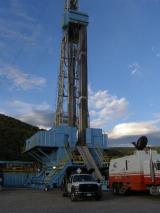Radioactive Waste Material From Oil and Gas Drilling
Radiation Facts
- Naturally radioactive materials that are brought to the surface and concentrated by industrial processes are called Technologically Enhanced Naturally-Occurring Radioactive Material (TENORM).
- Wastes generated from oil and gas drilling must be properly managed to keep radionuclides in these wastes from spreading to surrounding areas.
Rocks in and around certain oil- and gas-bearing formations may contain natural radioactivity. Drilling through these rocks or bringing them to the surface can generate waste materials that contain radioactivity.
- Once oil and gas have been extracted from the formation, workers and members of the public may be exposed to radionuclides that are brought to the surface.
- Because materials have been relocated to the surface and/or are concentrated because of industrial processes, they are called Technologically Enhanced Naturally-Occurring Radioactive Material (TENORM).
About Radioactive Waste Material From Oil and Gas Drilling
Radionuclides are found naturally in almost all soils, rocks, surface water and groundwater. Bringing natural resources from below the surface to above the ground also brings up materials that naturally contain radionuclides. These naturally radioactive materials are called TENORM. Radionuclides commonly found in TENORM are radium, radon, uranium, potassium and thorium. The level of radioactivity in TENORM can vary widely.
TENORM can be found in solids, liquids, sludges and/or gases. It’s possible for TENORM to come from different parts of the oil and gas extraction processes. Here are a few examples:
- Drill cuttings: When drilling for oil and gas, rock is ground into small pieces using a sharp bit. These pieces of rock, called drill cuttings, can contain radioactive elements that are found inside the rock.
- Flowback and produced water: These terms describe the water that comes back to the surface during and after drilling. Flowback water is the solution that returns to the surface after injecting materials into the well for fracking. Industrial water, sand and chemicals mix with water in the formation to create flowback water. Produced water is the salty liquid that is brought to the surface with oil and gas after the well is developed and put into production.
- Pipe scale: When water is pumped in and out of well and storage tanks, a coating called pipe scale builds up around the inside of the pipe. Pipe scale is made up of the natural minerals found in water, which sometimes include radionuclides. Radioactivity in pipe scale can be quite high.
- Sludges, sediments, and filters: Sludge is an oily, loose material from produced water that often ends up in water storage tanks. Sediments are the more solid material, often present in water storage tanks. Filters can contain TENORM that is captured as liquid and gas passes through.
Wastes generated from oil and gas drilling must be properly managed to keep the radionuclides in these wastes from spreading to surrounding areas. One factor that affects the movement of radionuclides in the environment is how well they dissolve in water (solubility). For example, radium is more soluble than thorium. Therefore, under certain conditions, radium can spread more easily through the groundwater.
Employees who work at drilling sites are the most likely group to be exposed to TENORM from oil and gas drilling and production. Some states have worker safety programs in place to ensure workplace safety. To learn more about oil and gas drilling sites in your area, contact your state geological survey or health department.
What You Can Do
- Obey safety instructions. It’s important to follow any posted safety instructions near oil and gas drilling or production-sites.
- Never handle, dispose of or re-use abandoned equipment used at these sites. Do not go near abandoned oil and gas drilling sites.

